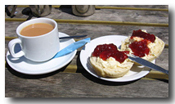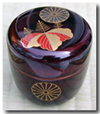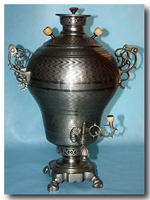|
Contents:
More:
|
Tea Around the World Tea and traditional tea ceremonies vary across the globe. Read about a few of them.
• China • England • Ireland • Japan • Poland • Russia • Wales •
Some of the most popular teas in China include black, green, oolong, white and yellow. Common names consist of Big Red Robe, Dragon Well, Houkui, Iron Goddess, Maojian, Melon Seed, Mount Jun Silver Needle, Qi Men Red, Spring Snail and Yellow Mountain Fur Peak.
The tea ceremony in China is known as gongfu cha. Custom indicates the tea be served for a purpose, such as showing respect for elders, to mark a family gathering or to apologize among others. The six basic elements of the ceremony consist of Attitude (the host should possess a calm and relaxed demeanor to ensure an enjoyably peaceful ceremony), Tea Selection (fragrance, shape and taste are important, but the tea should also have a beautiful name with a back-story), Water Selection (pure water ensures good tea), Teaware Selection (appropriate teaware for a particular gathering), Ambiance (a peaceful environment is achieved by having a clean and comfortable room), and finally Technique (basic skills for tea-brewing are necessary but graceful demeanor in physical self and clothing are also important).
The finer points of Chinese tea etiquette include:
Tea in England can resemble a meal in itself. It is also a highly social event in some households. Home tea is a common practice, and can become quite formal. For example, the woman of the household might decide on the day of the week in which to hold her tea party, and then send out announcements. Food on hand would typically consist of cakes, sandwiches or scones, all washed down with tea and accompanied by some sort of sweet preserves. There is also a social "etiquette" which must be followed:
There are three types of "social" visits surrounding tea. The first is a congratulations or condolences type of social gathering when appropriate. A card is left for the hostess announcing the guest, and they may or may not be received. The second is when a current guest announces the visit of another, and the visit is brief. The third visit is that of friendship; the friend only visits during the appointed hours and the rules of behavior are less strict.
There were no complex rules to drinking tea with the working class. Sometimes "high tea" took the place of dinner in homes when a proper hot meal was not affordable. High tea was a family meal, and took place normally between five and seven p.m. at night. The food typically consisted of cold chicken, game, salad or tarts, but a few hot dishes were served as well (such as soup or warm-baked bread). In reality, tea was not a luxury to the working class, but an absolute daily necessity.
Popular Brands of British Tea: There are literally hundreds of types of English tea available, and several different name-brands. Some of the more popular name-brands include Tetley, Berry Brothers & Rudd, Fortnum & Mason, Glengettie, Heath & Heather, Jackson's, Melrose's, Nambarrie, PG Tips and Twinings, just to name a few.
There are also many different flavors of tea in England.
Common Tea Food in England: There are many foods eaten with the tea in England. Some of the more common tasty treats include scones, clotted cream, muffins, thin-cut brown bread with butter, jam and honey, marmalade, soft-boiled eggs, curds, fish and meat pastes, a selection of sandwiches ranging from diced cheese and tomato, grated egg, cucumber, breast of chicken, tongue and ham; potted shrimps, cakes and biscuits.
To get a really "Good Cuppa," it is suggested to warm the teapot before brewing the tea. Once the teapot is nicely warmed, spoon the loose tea into the pot and add boiling water slowly. Tea can be drunk as is, or with milk, cream, sugar or lemon.
The Irish "cupan tae" ("cup of tea") is as traditional in Ireland as Guinness and the potato. Tea was first imported into Ireland in 1835. The majority of tea is now imported from East Africa and Sri Lanka. The average person in Ireland consumes up to seven pounds of tea per year. Nothing is as soothing and comforting as a good cup of "tae" as it buffers against the elements of wet Irish weather.
Basic Irish Teas
Popular brands of tea in Ireland are Barry's Teas (est. 1901) and Bewley's (est. 1840). Perhaps the most consumed tea blend is Barry's Blends, some of which include Gold, Classic and Green labels, both in loose tea and tea bags. Tea is big business in Ireland.
Irish Tea Traditions:
Tea is one of the most popular beverages in Japan. It is sold at vending machines, hot or cold. Some of the common tea-types include:
Formal Tea Ceremony: Also known as the "The Way of Tea," the formal Japanese tea ceremony is quite elaborate. Even before tea is served, ceremonial preparation methods (chanoyu) are followed to the letter. There are also different classifications of the tea ceremony, including:
Thick tea" typically involves using the best quality tea leaves, while "thin tea" is of lesser quality (sometimes made from tea leaves that double as packing material). Koicha is blended gently until smooth, adding to its felt superiority. Usucha is whipped with a tea whisk.
The changing seasons are an important part of tea ceremonies. Those who practice the edicts of tea ceremonies pay attention to the seasons, which are broken into two elements: brazier (furo, May to October) and sunken earth (ro, November to April).
Tea is usually taken on tatami floor mats, where it is prepared by the host and served to guests. A more elaborate venue, such as specially-built tea rooms (chashitsu) might have display alcoves, calligraphic scrolls to mark the theme of the occasion, hearths built into the floor, various flower arrangements, shoji screens and separate preparation areas (mizuya). Some of the common equipment (chadogu) used to prepare tea includes bowls (chawan), caddies (natsume), linen and hemp clothes for clean-up (chakin), bamboo scoops (chashaku) and whisks (chasen).
Elements of the tea ceremony are also related to Zen Buddhism, which promotes harmony as well as the simple enjoyment of the event itself.
Herbal remedy and fruit teas common in Poland:
Herbal Teas
Fruit Teas
Tea was first introduced to Russia in 1638, when Altan Khan of Mongolia gifted Tsar Mikhail Romanov with four pounds of tea leaves. At first, it was only available to royalty and those possessing great wealth because of its high cost related to difficult trading routes. Members of the upper-class typically ornamented their tea with sweet concoctions such as cakes, candy, jam preserves, syrup and other sugary desserts.
It wasn't until 1736 when Catherine the Great permitted regular import of tea, which increased to three million pounds in trade by the time of her death sixty years later. Pricing declined near the end of the 18th-century, allowing the middle and lower classes to purchase loose tea in the form of bricks. According to a 2005 study, 82% of Russians now drink tea on a daily basis.
Types of Russian tea include:
Russians appear to favor a strong brew of tea, preferably sweetened with honey, sugar or jam. Even though tea was introduced by China, Russians have their own traditions surrounding the drink. Typically, tea is a mix of two or three different types and flavors. The tea is brewed to be quite strong and dark. Sometimes a bit of hot water is added to dilute the flavor.
A majority of Russian tea is imported from India and Sri Lanka, although it is also grown near the city of Sochi in the Krasnodar Krai federal district. Tea bags are rarely used in Russia. Loose tea is brewed in a teapot or "samovar." The hot drink is sipped from a "podstakanniki" (under the glass), which are silver holders containing the heat-tempered glass. They are similar to Turkish tea cups.
For a "quick cup," a small pot is used to produce "zavarka" (concentrated brew). A large quantity of tea leaves are placed in the pot with boiling water. The minimum steeping time is five minutes (much longer for a stronger cup). The beverage is enjoyed by Russians all day long, not just at teatime.
The different designs of samovars include vase-shaped, pear-shaped, wineglass-shaped, oval, and so on. Samovars are present in offices, homes and restaurants, as well as with the street-vendors. Samovars are not only considered "domestic utensils," but they can become works of art as well.
The first documented samovar-makers in Russia were the Lisitsyn brothers, who registered their factory in 1778. Samovars are also common in Azerbaijan, China, Iran and Turkey.
Tea is as traditional in Wales as it is in neighboring England. Typically, tea in Wales is served at four in the afternoon. It is known as te bach ("little tea"). Bara Brith (speckled Welsh bread) is often lathered with salty butter and washed down with hot cups of tea.
More than likely, tea will also include homemade breads, scones, jam; pikelets (crumpets), stacks of Ffroes (pancakes), clotted cream, treacle tart, Welsh cakes (sweet tea biscuits), Teisen Carawe (Caraway Seed Cake), Teisen Ferw (boiled cake), Teisen Sinamon (Cinnamon Cake), Teisen Mel (honey cake), Teisen Lap (Welsh fruit cake), Bara Planc (Bakestone bread), Bara Claddu (fruited bread) and Cacen Gneifio (shearing cake).
Tea is a favorite part of the day for the Welsh. Bread is much-loved in Wales. One of the more popular treats is savory oatcakes served with butter and cheese (Bara Ceirch). While most cakes are baked, in Wales they are also cooked on a griddle.
Popular teas in Wales include Glengettie (produced by Typhoo with Welsh and English packaging) and Paned Gymreig (Murroughs Welsh Brew), which is blended and sold by Adwell Foods.
|



 English Working Class Tea: Not everyone in England had a special tea
party every week, and in fact the majority of people in England were from the
working class. Working class tea was much different than a fashionable event,
although it was a chance to socialize with other employees. It was a much-needed
break from work. Tea has been consumed by the working class in England since the
19th century, although it was not as available in some households at the time.
The diet of the working class was poor in the 19th century, when malnutrition
was a serious problem. The primary sources of food for the working class were
bread, potatoes, and strong tea. By 1871, the average person drank around four
pounds of tea per year.
English Working Class Tea: Not everyone in England had a special tea
party every week, and in fact the majority of people in England were from the
working class. Working class tea was much different than a fashionable event,
although it was a chance to socialize with other employees. It was a much-needed
break from work. Tea has been consumed by the working class in England since the
19th century, although it was not as available in some households at the time.
The diet of the working class was poor in the 19th century, when malnutrition
was a serious problem. The primary sources of food for the working class were
bread, potatoes, and strong tea. By 1871, the average person drank around four
pounds of tea per year. Taking
tea is a polite way to entertain guests. The correct way to drink a cup of tea
is to take the teacup and return to your position in the seating arrangement.
Place the teacup between yourself and your guest. After this, place the teacup
in front of your knees and bow to the guest. Then take the teacup with your
right hand and place it on the palm of your left hand. Turn the teacup to the
right twice to avoid sipping from the front of the cup, and then drink. Finish
the tea to the last drop. Lastly, turn the cup to the left twice and place it on
the table in front of you.
Taking
tea is a polite way to entertain guests. The correct way to drink a cup of tea
is to take the teacup and return to your position in the seating arrangement.
Place the teacup between yourself and your guest. After this, place the teacup
in front of your knees and bow to the guest. Then take the teacup with your
right hand and place it on the palm of your left hand. Turn the teacup to the
right twice to avoid sipping from the front of the cup, and then drink. Finish
the tea to the last drop. Lastly, turn the cup to the left twice and place it on
the table in front of you. Samovar:
A "samovar" is a traditional Russian teapot. They can vary in size, with some
being quite small (3 liters) while others hold up to 30 liters. There are simple
samovars for the common home, yet they can also become quite elegant. The
samovars resemble English tea urns, but have a spout and handle instead of a
tap. They are made from assorted metals such as copper, bronze, copper and iron.
Plated silver is the most used, and the base metal is always brass.
Samovar:
A "samovar" is a traditional Russian teapot. They can vary in size, with some
being quite small (3 liters) while others hold up to 30 liters. There are simple
samovars for the common home, yet they can also become quite elegant. The
samovars resemble English tea urns, but have a spout and handle instead of a
tap. They are made from assorted metals such as copper, bronze, copper and iron.
Plated silver is the most used, and the base metal is always brass.